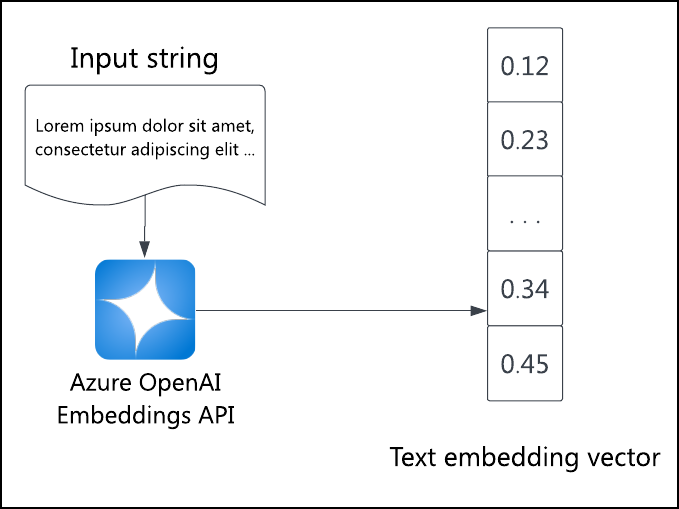Create embeddings with the Azure AI extension
To run a semantic search, you must compare the query embedding with the embeddings of the searched items. The azure_ai extension for Azure Database for PostgreSQL - Flexible Server integrates with Azure OpenAI to generate embedding vectors.

Introduction to azure_ai and Azure OpenAI
The Azure Database for PostgreSQL flexible extension for Azure AI provides user-defined functions to integrate with Microsoft Foundry including Azure OpenAI and Azure AI Search.
The Azure OpenAI Embeddings API generates an embedding vector of the input text. Use this API to set the embeddings for all items being searched. The azure_ai extension's azure_openai schema makes it easy to call the API from SQL to generate embeddings, whether to initialize item embeddings or create a query embedding on the fly. These embeddings can then be used to perform vector similarity search, or in other words, semantic search.
Using the azure_ai extension with Azure OpenAI
To call the Azure OpenAI Embeddings API from PostgreSQL, you need to enable & configure the azure_ai extension, grant access to Azure OpenAI, and deploy an Azure OpenAI model. For more information, see the Azure OpenAI on Azure Database for PostgreSQL Flexible Server documentation.
Once the environment is ready and the extension is allow-listed, run this SQL:
/* Enable the extension. */
CREATE EXTENSION azure_ai;
You also need to configure your OpenAI service resource's endpoint & access key:
SELECT azure_ai.set_setting('azure_openai.endpoint', '{your-endpoint-url}');
SELECT azure_ai.set_setting('azure_openai.subscription_key', '{your-api-key}}');
Once azure_ai and Azure OpenAI are configured, fetching and storing embeddings is a simple matter of calling a function in the SQL query. Assuming a table listings with a description column and a listing_vector column, you can generate and store the embedding for all listings with the following query. Replace {your-deployment-name} with the Deployment name from the Azure OpenAI Studio for the model you created.
UPDATE listings
SET listing_vector = azure_openai.create_embeddings('{your-deployment-name}', description, max_attempts => 5, retry_delay_ms => 500)
WHERE listing_vector IS NULL;
The listing_vector vector column must have the same number of dimensions as the language model produces.
To see a document embedding, run the following query:
SELECT listing_vector FROM listings LIMIT 1;
The result is a vector of floating point numbers. You can run \x first to make the output more readable.
Generate a query embedding dynamically
Once you have embeddings for the documents you want to search, you can run a semantic search query. To do so, you also need to generate an embedding for the query text.
The azure_openai schema of the azure_ai extension lets you generate embeddings within SQL. For example, to find the top three listings whose text is most semantically similar to the query "Find me places in a walkable neighborhood," run the following SQL:
SELECT id, description FROM listings
ORDER BY listing_vector <=> azure_openai.create_embeddings('{your-deployment-name}', 'Find me places in a walkable neighborhood.')::vector
LIMIT 3;
The <=> operator calculates the cosine distance between the two vectors, the semantic similarity metric. The closer the vectors, the more semantically similar; the further the vectors, the more semantically different.
The ::vector operator converts the generated embeddings to PostgreSQL vector arrays.
The query returns the top three listing IDs and descriptions, ranked from less to more different (more to less similar).